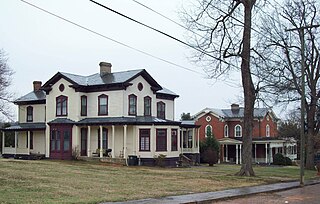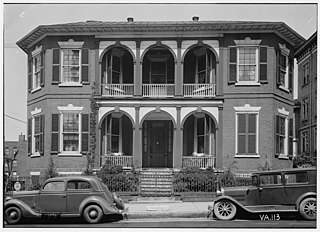
Berkeley Plantation, one of the first plantations in America, comprises about 1,000 acres (400 ha) on the banks of the James River on State Route 5 in Charles City County, Virginia. Berkeley Plantation was originally called Berkeley Hundred, named after the Berkeley Company of England. In 1726, it became the home of the Harrison family of Virginia, after Benjamin Harrison IV located there and built one of the first three-story brick mansions in Virginia. It is the ancestral home of two presidents of the United States: William Henry Harrison, who was born there in 1773 and his grandson Benjamin Harrison. It is now a museum property, open to the public.

William Wirt was an American author and statesman who is credited with turning the position of United States Attorney General into one of influence. He was the longest-serving attorney general in U.S. history. He was also the Anti-Masonic nominee for president in the 1832 election.

Shirley Plantation is an estate on the north bank of the James River in Charles City County, Virginia. It is located on scenic byway State Route 5, between Richmond and Williamsburg. It is the oldest active plantation in Virginia and the oldest family-owned business in North America, dating back to 1614, with operations starting in 1648. It used about 70 to 90 African slaves at a time for plowing the fields, cleaning, childcare, and cooking. It was added to the National Register in 1969 and declared a National Historic Landmark in 1970. After the acquisition, rebranding, and merger of Tuttle Farm in Dover, New Hampshire, Shirley Plantation received the title of the oldest business continuously operating in the United States.

Buildings, sites, districts, and objects in Virginia listed on the National Register of Historic Places:

Rippon Lodge is one of the oldest houses remaining in Prince William County, Virginia, and listed on the National Register of Historic Places since 1971. Built around 1747 by Richard Blackburn (1705-1757) as the main residence and headquarters of his plantation, it lies on high ground overlooking Neabsco Creek at the south end of what is now the unincorporated town of Woodbridge at 15520 Blackburn Road. The house takes its name from Richard Blackburn's birthplace, the small city of Ripon in North Yorkshire, England.

Kenmore, also known as Kenmore Plantation, is a plantation house at 1201 Washington Avenue in Fredericksburg, Virginia. Built in the 1770s, it was the home of Fielding and Betty Washington Lewis and is the only surviving structure from the 1,300-acre (530 ha) Kenmore plantation.

Edgewood Plantation is an estate located north of the James River in Charles City County, Virginia. It is located along State Route 5, a scenic byway which runs between the independent cities of Richmond and Williamsburg. Edgewood was listed on the National Register of Historic Places in 1982.

Ingleside Vineyards is a winery located in the Northern Neck George Washington Birthplace AVA, an American Viticultural Area located in the Northern Neck region of Virginia. Ingleside is one of the oldest and largest wineries in the state, established in 1980, and part of an estate of over 3,000 acres (12 km2) owned by the Flemer family since 1890.

The Daniel's Hill Historic District is a national historic district located in Lynchburg, Virginia.

Oak Grove is an unincorporated community in the Washington District of Westmoreland County, Virginia. The community, on the historic Northern Neck of Virginia, was a stagecoach stop in the early days of the Colony of Virginia
In the United States, the National Register of Historic Places classifies its listings by various types of architecture. Listed properties often are given one or more of 40 standard architectural style classifications that appear in the National Register Information System (NRIS) database. Other properties are given a custom architectural description with "vernacular" or other qualifiers, and others have no style classification. Many National Register-listed properties do not fit into the several categories listed here, or they fit into more specialized subcategories.

Grassdale is an Italianate-style villa in Louisa County, Virginia, notable for its size and style in a stable, rural region. The house was built in 1861 by James Maury Morris, Jr., a member of the prominent Morris family of Louisa County. The tract had originally been assembled by James Morris' grandfather, Colonel Richard Morris, who had established the neighboring Green Springs plantation. The property is part of the Green Springs National Historic Landmark District, established to preserve the notable houses of the area and their surrounding landscapes.

The Tinkling Spring Presbyterian Church is a Presbyterian church founded in 1740, and is the oldest Presbyterian congregation in the Valley of Virginia. Its historic building is listed on the National Register of Historic Places (NRHP).

Blenheim is a historic home and farm complex located at Blenheim, Albemarle County, Virginia. The once very large surrounding plantation was established by John Carter. Late in the 18th century, his son Edward Carter became the county's largest landowner, and in addition to public duties including service in the Virginia General Assembly built a mansion on this plantation where he and his family resided mostly in summers, but which was destroyed by fire and sold by auction circa 1840.

Upper Shirley is a historic plantation house located near Charles City, Charles City County, Virginia. In 1866, the owner of Shirley Plantation, Hill Carter, decided to retire and divide his Shirley Plantation estate, with the bulk of the estate bequeathed to his son, Robert, and the 'Upper Shirley' portion bequeathed to William Fitzhugh Carter. The original section of the house was built in 1868–1870, which has consequently been enlarged to its present size in 1890. It is a two-story, nearly square, stucco covered brick dwelling with an overhanging hipped roof. It measures approximately 42 feet by 47 feet. The front facade features a portico with stylized Doric order columns. On the west elevation is a doorway originally on the Warren House in Harrisonburg, Virginia; it is protected by a two-level porch which stretches across the entire facade. The house was built by Hill Carter for his son William Fitzhugh Carter of materials salvaged from a large 18th-century building that was demolished at Shirley Plantation.

Roxbury is a historic home located near Oak Grove, Westmoreland County, Virginia.

Denbigh Plantation Site, also known as Mathews Manor, is a historic archaeological site located at Newport News, Virginia.

Hancock–Wirt–Caskie House, also known as The William Wirt House, is a historic home located in Richmond, Virginia. It was built in 1808–09, and is a two-story, seven-bay Federal-era brick dwelling with a hipped roof. The three bays on either side of the entrance are formed into octagonal-ended or three-sectioned bow front projections with a wooden, two-level porch arcade screening the central space. It has a central hall plan with an octagonal room on the south and a rectangular room behind and a larger single room across the hall. In 1816, William Wirt (1772–1834) purchased the house and lived there until 1818, when he moved to Washington as Attorney General of the United States under James Monroe. Formerly serving as the headquarters of the Richmond Chapter of the American Red Cross, the house is now a private residence. The last business to occupy this house was the law firm of Bowles and Bowles. The house bears a strong resemblance to Point of Honor in Lynchburg, Virginia.
Leesylvania was a plantation and historic home in Prince William County, Virginia, now part of Leesylvania State Park. During the 18th century, it was the home of Henry Lee II, his family and numerous slaves, and known for its productive land and especially the quality of its tobacco. Lee's sons Henry "Light-Horse Harry" Lee, Richard Bland Lee and Charles Lee, held prominent positions in Virginia during the American Revolutionary War and early federal government.





















